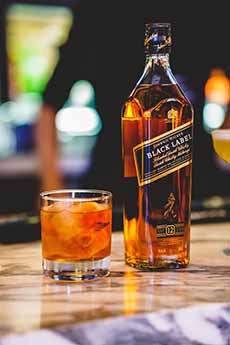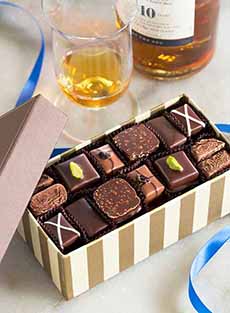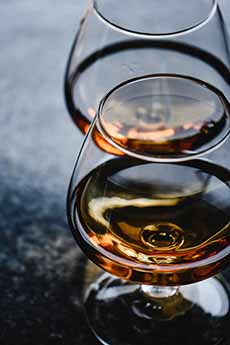Scotch Whisky Fudge & Types Of Scotch: It’s National Scotch Day
|
July 27th is National Scotch Day. It’s a reason to pour yourself a dram (or glass, as we say in the U.S.) of your favorite amber libation. We’ve got some Scotch-infused fudge for you, below. But first, a bit about the whisky itself. While alcohol has been distilled since the eighth century, the first known written mention of Scotch whisky is in the 15th century. The Exchequer Rolls of Scotland of 1494 note that Friar John Cor distilled Scotch whisky at Lindores Abbey. While whisky became a palliative and an enjoyable spirit, inevitably, it became a new source of revenue for the government. Whisky production was first taxed in Scotland in 1644, causing a rise in illicit whisky distilling. In 1782, more than 1,000 illegal stills were seized in the Highlands—a fraction of those in operation. Originally made from water plus malted barley (as is beer), commercial distilleries began introducing whisky made from wheat and rye in the late 1700s. Scotch is still made from these three grains; the different types of Scotch follow. Here’s more about the history of Scotch. Scotch whisky is divided into five distinct categories: At the end of the day, the best Scotch is the one that tastes best to you. Modern Scotch must be aged for at least three years in oak barrels, in one of five areas in Scotland: As of 2020, there were 134 Scotch whisky distilleries operating in Scotland. Each region delivers different flavors and aromas, from light and fruity to rich and spicy to powerfully smoky (like the peaty Scotches of Islay, our personal favorite style). In each region, several natural elements (the terroir, a French word pronounced tur-WAH) have an impact on the final flavors and aromas of the spirit. These range from the minerals in the local water, to the composition of the peat that smokes the malted barley, to the general climate and the seasonal weather that affects aging in the barrelhouses, to the wood of the barrels themselves [source]. In Scotland, you’ll be served a dram of Scotch. What’s a dram? It depends on who’s pouring, but it refers to a single serving of whisky. There is no official definition of a dram in Scotland. You can have a wee dram—just a taste—or a hearty dram. The U.S., however, does have a precise definition in the United States Customary System, the set of rules that defines the length, size, and volume of units like foot, acre, and cubic inch. In the U.S., a dram refers to one-eight of a fluid ounce, less than a teaspoon. That’s hardly enough for the mouse immortalized in a poem by Scotland’s national poet, Robert Burns (1759 – 1796). Now, you can enjoy that dram of Scotch with a piece of Scotch-infused fudge. Scotch with chocolate is a good pairing, so why not a good piece of fudge? The Mill Fudge Factory in Bristol, New Hampshire makes a Scotch-infused fudge that has many fans. With a uniquely complex flavor far beyond taste of sweet fudge, there’s the sweet taste of malted barley, followed by the warm and spicy experience of a good Scotch. The silky, melt-in-your-mouth fudge has just the right blend of sweetness with the subtle flavor of whiskey, and is the favorite flavor of many customers. Order a box for yourself or for a Scotch-and-sweets lover. It’s on our holiday gift list. You can also find limited-edition chocolates with whiskey-infused ganache from two of our favorite chocolatiers, Burdick and Delysia. Whisky is the Scottish spelling of whiskey, the earlier, Irish spelling. The alternative spelling was chosen to differentiate the national product from Irish whiskey, the production of which preceded Scotch whisky. The “whisky” spelling is used in Canada, Japan and Wales, as well as Scotland. In the United States, a 1968 directive from the Bureau of Alcohol, Tobacco and Firearms specifies “whisky” as the official U.S. spelling. However, it allows the alternative spelling, “whiskey.” Most U.S. producers prefer to include the “e,” as do we. Without it, it looks like something is missing. And another reason to keep the “e”: the production of Irish whiskey predates that of Scotch whisky. Check out this brief history of whiskey. Ironically, distillation was discovered in the 8th century in Persia—a country that has not permitted the sale and consumption of spirits since the 1979 Islamic revolution. |
|
|
|
|
||









